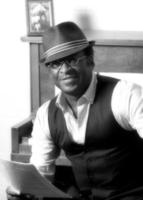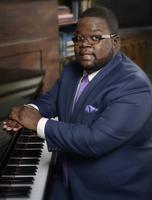Antiphony, Otherwise: Speakers & Abstracts
 Kyle Brooks
Kyle Brooks
Visiting Assistant Professor of Homiletics and Black Church and African Diaspora Studies, and Louisville Institute Postdoctoral Fellow at the Methodist Theological School in Ohio
As I Come to a Close: The Hammond B3, Whooping, and Homiletical Theory
The term whooping refers to the black church expressive practice of melodically-intoned speech, usually practiced within a sermon or in prayer. Ashon Crawley explores this practice in his text Blackpentecostal Breath, describing whooping as a practice that “aestheticizes breath,” expressing both the fullness of black life and a critique of white supremacist antiblack violence (Crawley, 46). What warrants further interrogation is how this practice, particularly within preaching, is augmented or punctuated by the “aestheticized breath” of the Hammond B3 organ. Skilled musicians wield a deft control over the instrument as they help to shape the sonic contours of the celebratory experience alongside and in conversation with preachers and congregants. In this paper, I argue for how the Hammond B3 organ functions as a sustainer of respiration that modulates the breathing capacity of whooping. The organ’s output produces a contextual and temporary arrangement of atmosphere: a sonic cosmology designed not for permanence, but transience, vibration, the occupation of multiple yet simultaneous states of being. Extending this idea to homiletical theory, I assert that these blackpentecostal aesthetics, as a challenge to Western theological and philosophical logics, furnish a constructive framework for understanding the communication of gospel preaching as likewise contextual, temporary, and contingent - a centrifugal expression of multiple truths, rather than a reduction to singular meaning.
 Lynnée Denise
Lynnée Denise
DJ, Adjunct professor in the Pan African Studies Department at California State University, Los Angeles
The Organist and the DJ: A Case Study in Turntablism, Jazz, and the Hammond B-3 as a Sound System
The Hammond as the primary sonic force beneath gospel music prompts a necessary investigation of the connection between the organ’s black church roots and the subsequent genres of music that incorporate the Hammond as part of its dominant sound. By using DJ Scholarship, a mix-mode research practice that positions the DJ as an archivist and information specialist who assesses, collects, organizes, and provides access to music determined to have long-term value, I will explore the role of the organ as it appears in multiple forms of music and pay close attention to the relationship between the Hammond, turntablism, and cultural production across genre. This interdisciplinary project uses film to critically examine the evolution of the organist while “digging through the crates” of innovative musicians and artists who were responsible for populating reggae, jazz, and soul with the sound of the Hammond organ.
 Fredara Hadley
Fredara Hadley
Visiting Assistant Professor of Ethnomusicology at Oberlin College
Endowed with Genius: In Praise of Elbernita ‘Twinkie’ Clark’
Elbernita “Twinkie” Clark is a prolific composer, astute arranger, gifted singer, and the “Queen of the Hammond B-3.” She is one of the few women gospel musicians for whom playing her instrument has remained a staple of her performance and recording. The central question of this paper is: What understandings are revealed when we view Twinkie Clark’s Hammond B-3 genius as a tool of both familial artistic intimacy that connects three generations of the Clark family, as well as a genius that helped facilitate the transformative role of the Church of God in Christ’s (COGIC) acclaimed International Music Department?
The inclusion of the word “genius” is more than descriptor. It is a framework for acknowledging and valuing the contributions of Black women in music. The frame for this exploration comes from scholars who thoughtfully unpacked the locus of Black Women musical genius. Farah Jasmine Griffin’s definition of genius says that genius completes “specific tasks and work,” Angela Davis’ research carries the notion of the efficacy of genius in her research on Black blueswomen, and Pearl Williams-Jones elucidates key aspects of gospel performance prowess. It is through these theoretical guides that Twinkie Clark’s Black feminine genius is firmly situated as an alchemical virtuoso in her immediate family, the COGIC denomination, and African American music.
 Johari Jabir
Johari Jabir
Associate Professor of African American Studies at the University of Illinois, Chicago
The Hammond B-3 and the Black Fantastic
The Hammond B-3 arrived in the religious and cultural context of the Black Working Class during the Great Migration. While the instrument was intended to be a cost-alternative to the traditional pipe organ, the B-3 proved to be a critical form accompaniment in the liturgical labor of Black churches. I will discuss the ways the instrument’s features, namely “tremolo” and “vibrato,” contribute to a Black sonic sense of the holy. The earliest arrival of the Hammond B-3 at First Church of Deliverance in Chicago, Illinois speaks to the importance of the Spiritual Church in terms of how this instrument was honed on a Black Working Class Cosmology. This combined sense of the sacred and class consciousness was extended beyond the church and is heard on the 1959 album, “The Sermon,” by Jimmy Smith. Across several genres of music, the gospel musician’s imprint on the Hammond B-3 is a sonic symbol of what Richard Iton calls the “Black Fantastic.” The B-3 is used to conjure the church in order to destabilize proper notions of space, spirituality, sensuality, and politics in pursuit of freedom.
 P. Kimberleigh Jordan
P. Kimberleigh Jordan
Assistant Professor of Religion and the Arts and Black Studies at Drew University
“Move, Daniel”/Shout, Daniel: Fathoming Space between Ring and Shout in Black Sacred Performance
The Ring Shout is an enfleshed spiritual practice performed by African-descended people along the Eastern Seaboard of North America (and elsewhere) prior to the mid-twentieth century. The Hammond B-3 organ made its debut in Black faith communities in the twentieth century as the Ring Shout reached the nadir of its practice in Black communities of faith. Paying attention to these two facts, this presentation will be prospective. It will inquire and investigate the historical and theoretical spaces between the historical ring shout and twentieth century ecstatic performance related to Hammond B-3 performances. How do these historically distinct, but culturally related, spiritual practices give weight and power to each other? Are they in conflict? As quotidian practices, how is “humanity transmitted” and the survival of their Black practitioners made possible through countlessly reiterated performances? Both of these sacred performance practices have inscribed enduring legacies on Black life and religion.
 Braxton Shelley
Braxton Shelley
Stanley A. Marks and William H. Marks Assistant Professor at the Radcliffe Institute and Assistant Professor of Music in the Harvard Faculty of Arts and Sciences
Putting the Breath Back In: Twinkie Clark, Antiphony, and the Hammond Organ’s Vocality
This talk takes a deep dive into two of Elbernita “Twinkie” Clark’s paradigmatic Hammond Organ solos in order to reflect on the instrument’s alleged vocality. When viewed as indexes of Clark’s practice and of gospel performance in general, solos on “High Place” and “Great Is Thy Faithfulness” reveal a symphony of antiphonal practices that trouble the category of the solo itself. Both performances feature dynamic interactions between the organ’s speech and Clark’s voice, between imagined sound and enacted resonance, between musical syntax and instrumental affordance, offering windows into the embodied and extended forms of “cognition” that are grounded in the Hammond Organ. Ultimately, I will suggest that, although taxonomical vocabularies classify the Hammond Organ as an electromagnetic cousin to the pneumatic pipe organ, the instrument’s idiomaticity—its ubiquity in the worship practices of many black Christians—is all about putting the breath back in.